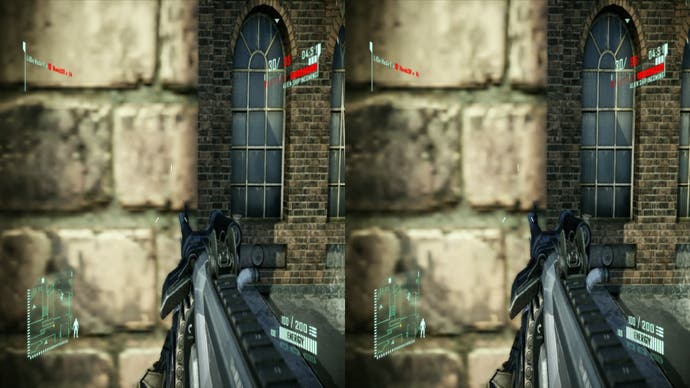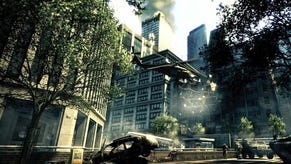Tech Analysis: Crysis 2 Demo
Crytek analysis!
The fact that nothing "pops out" from the screen could be a design decision (Crytek's own presentations suggest it's perfectly possible) but there are some drawbacks to using this technique: most notably, it's not true stereoscopy. In theory, walking up to a wall and positioning yourself so that one eye is obscured by a wall, while the other sees beyond it should produce two radically different views. Because the technique relies on a single 2D image being reprojected to each eye with an offset, this doesn't happen.
The issue is overcome somewhat by the fact that the default viewpoint from the player's perspective is somewhat behind the viewed weapon, so the opportunities for the stereoscopic effect to fail are limited.
Resolution for the 3D mode is an interesting topic. With the 2D game rendering at 1152x720, Crysis 2 has to somehow cram two images of this size into what you would assume is a 1920x1080 framebuffer. There are certainly more than enough pixels to go around, but the whole nature of side-by-side 3D means that the image is squashed into a non-widescreen format, resulting in rectangular pixels and unavoidable scaling artifacts. It definitely seems to be the case that the game is generating the two 1152x720 images, but then they are being downscaled horizontally and upscaled vertically to fit into the 1080p area.


The notion of 1080p being mandatory for the 3D effect is also intriguing as evidence suggests that Crysis 2 isn't actually using a native 1080p framebuffer - this manifested to us due scaling artifacts on the screen-tear, and required a great deal of effort to filter. But filter it we did, allowing us to analyse performance, and put some kind of real-world context around Cevat Yerli's claims that the 3D effect has very little impact on frame-rate.
"You will laugh now," Cevat Yerli told VideoGamer.com at E3 last year. "Our impact is 1.5 per cent. You play 2D or 3D, you have no difference. It's pretty much for free. People, when they ask how, I say it's our little magic.
"That's why we also can do it on 360. That's the ironic part of it. In a funny way, people banked their investment on PS3 or on other 3D solutions, thinking the 360 cannot do it. I'm saying, well, we've proven it. Whenever we show 3D, we show it intentionally on 360 to make the point. It works. It works flawless on PS3, 360 and PC as well. It just works; and one-and-a-half per cent impact only. Out of 30 frames it's 0.4 frames. So you don't notice it. That's what I want to say."
Those figures tie in pretty closely with what we've seen on TriOviz, so let's put this to the test in Crysis 2.
As you can see, there is an additional overhead to the 3D processing: rendering time for each frame goes over the 33.33ms budget allocated to a v-synced 30FPS game. To ensure the smoothest possible refresh, Crytek opts to disable v-sync: frame-rate is maintained at the target 30FPS but the overall image quality is impacted significantly by an ever-present tearing. Dropping out of 3D mode restores v-sync in the same capture session, proving it's not an external issue with our kit - it's just the way the game operates. Hopefully this will be optimised and improved in the final game.
The Crysis 2 multiplayer demo is a curious beast. There is a palpable sense of technical accomplishment in CryEngine 3's "tentpole" technical elements - the full, real-time global illumination system in particular provides a unique lighting to the game, and the sense of fluidity in the movement combined with what is a very solid frame-rate combines to make an FPS that feels very, very smooth indeed.
However, in other places the much-vaunted strengths of CryEngine 3 aren't really fully explored. The dynamic destruction model manifests only in the felling of some trees and collapsing walls, for example, while previous tech demos have promised so much more with prominent scenery collapsing in spectacular style. There's little evidence thus far that we'll see anything like the kind of game-changing destruction we've seen in Battlefield: Bad Company 2, for example.
But then again, we really are seeing just a very small section of the game and it is clearly way too soon to be coming to any kind of definitive conclusion. The second, secret Crysis 2 demo level already hints at a game capable of so much more than we're seeing thus far in the Skyline map.
That said, minor tech issues are annoying and these seem to be tied to some of the more aggressive config settings. Bearing in mind the lofty ambitions of the CE3 tech and its undoubted accomplishments it is also curious to see minor technical issues such as texture streaming pop-in, geometry pop-in and intrusive shadow cascades resulting in additional shadows appearing out of thin air.
Questions also remain over the PS3 version of the game, which hasn't been seen in any PR events thus far and has only been glimpsed in Crytek's own tech demos. Interestingly, the 360 demo also seems to include .cfg settings for the PS3 game, which closely match what we see on the Microsoft console in most respects, so hopefully we should be in for something equally special on all platforms.








